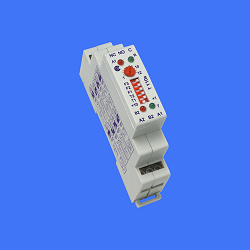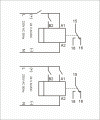FUNCTIONS
A. ON DELEY
After triggering, counting the time starts. At the end of time delay the relay is energized and remains in energized state until supply voltage has been removed. Cutting off power supply prior to energizing the relay causes the elapsed time to reset and the next cycle starts from zero.
A1. Power triggering. Counting the time starts once the supply voltage has been applied to A1 connecting terminal.
A2. Triggering through B2 control input. Counting the time is activated by a pulse at B2 control input providing the power supply is ON. If the voltage has been supplied to the control input prior to switching ON the power supply and remains ON until power supply has been switched ON, counting the time starts upon switching on the power supply.
B. PULSE TRIGGERED WITH RISING EDGE
The relay, once triggered, is energized and switches into working position. Counting the time starts. The relay is de-energized and drops out once the preset time has elapsed. Disconnection of supply voltage prior to elapsing the time causes the relay to drop out, the actual elapsed time is reset and the next cycle starts from zero.
B1. Power triggering. Counting the time starts once the supply voltage has been applied to A1 connecting terminal.
B2. Triggering through B2 control input (pulse generation): Counting the time starts once the pulse has been supplied to B2 control input. Power supply has to be continuously ON.
C. PULSE TRIGGERED WITH FALLING EDGE
Power s to be continuously ON. The pulse of duration equal to the time is triggered once the voltage has been removed from B2 control input. Disconnection of supply voltage prior to elapsing the time causes the relay to drop out immediately.
D. PULSE TRIGGERED WITH CHANGE OF THE STATE
Power upply has to be continuously ON. The pulse of duration equal to the present time delay is triggered once the state of B2 control input has changed. Disconnection of supply voltage prior to elapsing the time delay causes the relay to drop out immediately.
E. PULSE OF DURATION OF 0.5 SECOND DELAYED BY THE TIME T
Counting the time starts upon triggering, and once the preset time delay has elapsed, the relay generates a pulse of duration of 0.5 second. Cutting off power supply prior to elapsing the time delay causes the actual elapsed time to reset and the next cycle starts from zero.
E1. Power triggering. Counting the time starts once the supply voltage has been applied to A1 connecting terminal.
E2. Triggering through B2 control input. Counting the time starts once the pulse has been supplied to B2 control input. Power supply has to be continuously ON.
F. RETRIGGERABLE OFF DELAY
Power supply has to be continuously ON. The relay is energized and switches into working position once the voltage has been supplied to B2 control input. Relay drops out once the preset time delay (counted from voltage removal from the control input) has elapsed. Re-applying the voltage to the control input prior to elapsing the time delay causes that the relay does not drop out, and time counting starts from zero once the voltage has been removed again from the control input. Disconnection of supply voltage prior to elapsing the preset time delay causes the relay to drop out immediately.
G. NON-RETRIGGERABLE OFF DELAY
Power supply has to be continuously ON. The relay is energized and switches into working position once the control voltage has been supplied to B2 control input. Relay drops out once the set time (counted from voltage removal from the control input) has elapsed. Re-applying the voltage to the control input has no effect on time counting. If, at the time of relay de-energizing the voltage is present on the control input, the relay is energized and switches into working position with delay of 0.5 second from its previous dropout. Disconnection of supply voltage prior to elapsing the preset time delay causes the relay to dropout immediately.
H. SYMMETRIC FLASHER
Once the supply voltage has been switched on, the relay starts generating pulses of a period equal to double value of preset time delay and of pulse-filling coefficient equal 1/2.
H1. Start from no-pulse state (interruption). The work cycle starts from home position.
H2. Start from pulse. The work cycle starts from working position.
|




